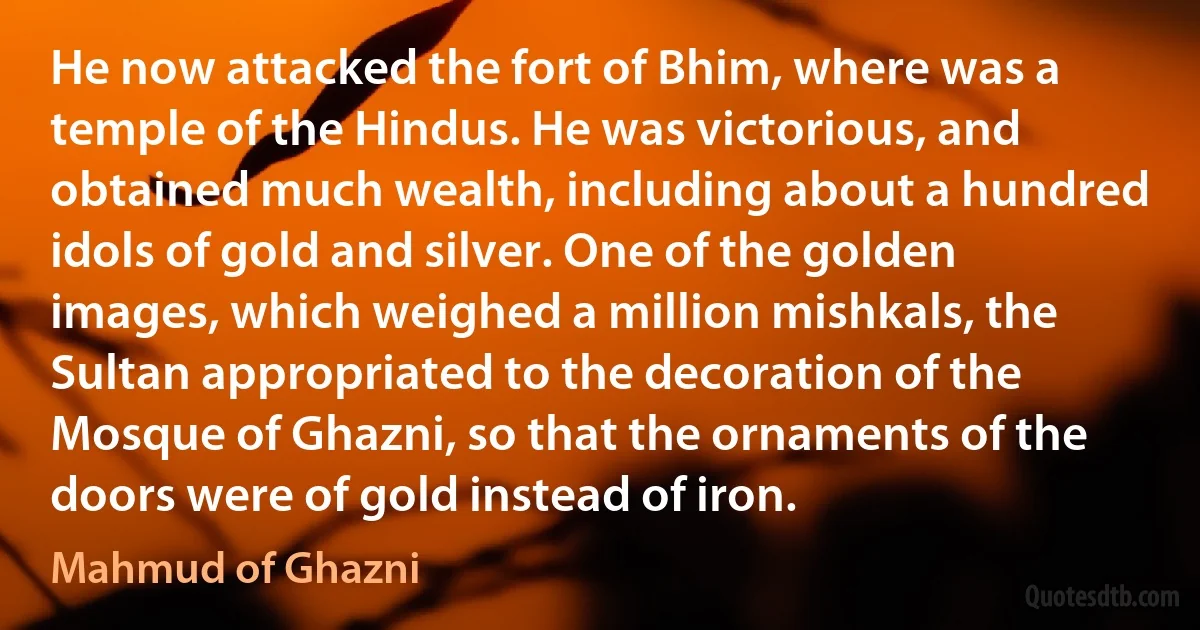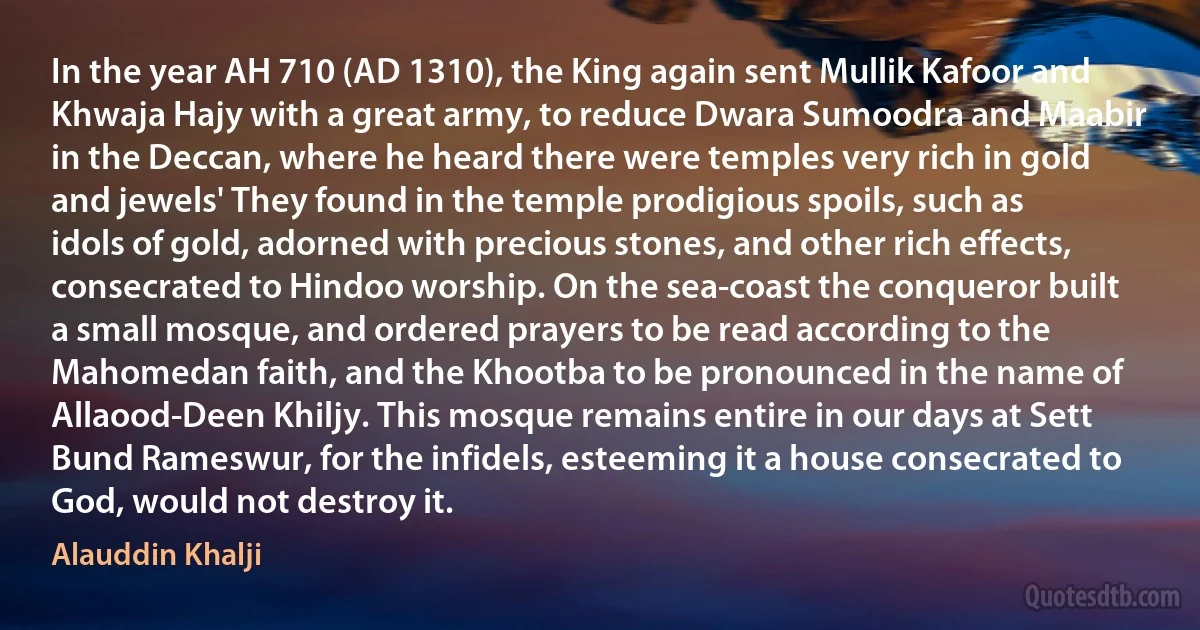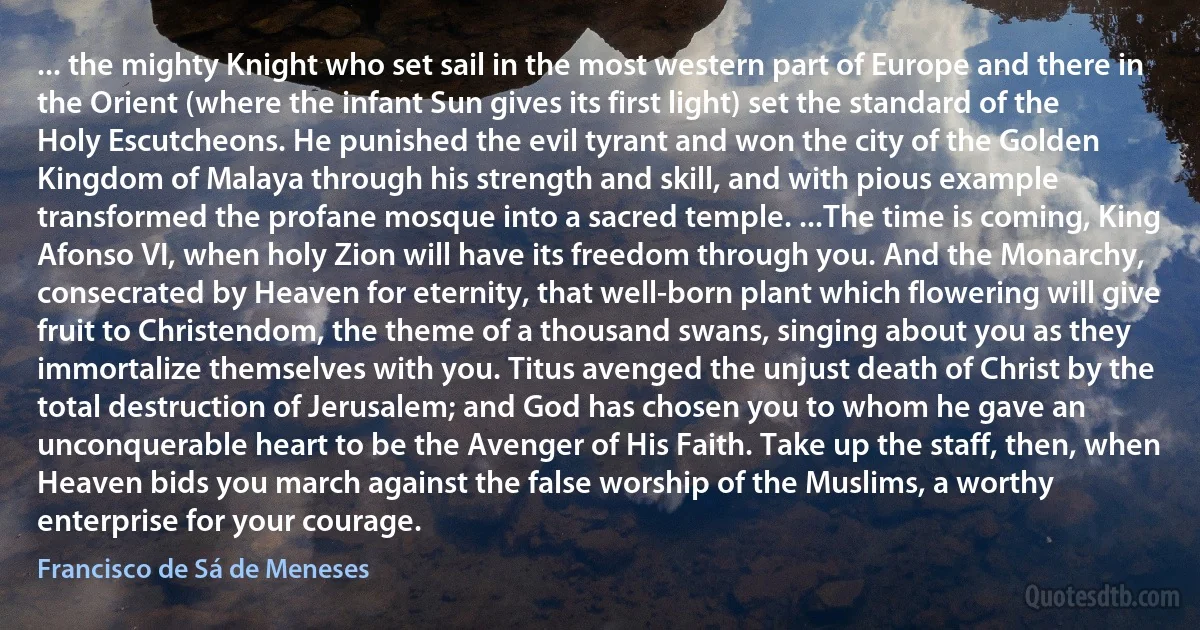Mosque Quotes - page 3
Waliullah had travelled all the way to Mecca and Medina - a difficult and dangerous undertaking in his days - and studied under half a dozen Sufis and savants of ‘Islamic sciences', only to ‘discover' and declare what the meanest mullah in the most obscure village mosque in India had been mouthing for more than a thousand years. He himself wrote as many as 43 books between 1732 and 1762 - thirty thoughtful years - only to re-echo the routine ravings of a thousand theologians who had continued to thunder ever since the advent of Islam in this country! He wrote hundreds of letters to his contemporary Muslim monarchs and mercenaries, including Ahmad Shah Abdali, whom he considered to be the saviours of Islam in India, only to convey the conventional Islamic message which all of them had crammed in their cradles - convert of kill the kãfirs, humiliate the Hindus, and establish an Islamic state in keeping with the ‘holy' commandments of the Quran!

Shah Waliullah Dehlawi
One day at Ahmadabad it was reported that many of the infidel and superstitious sect of the Seoras (Jains) of Gujarat had made several very great and splendid temples, and having placed in them their false gods, had managed to secure a large degree of respect for themselves and that the women who went for worship in those temples were polluted by them and other people... The Emperor Jahangir ordered them banished from the country, and their temples to be, demolished. Their idol was thrown down on the uppermost step of the mosque, that it might be trodden upon by those who came to say their daily prayers there. By this order of the Emperor, the infidels were exceedingly disgraced, and Islam exalted...

Jahangir
The Jami Masjid of Badaun, also built by Iletmish is one of the largest mosques in India. Following the traditional courtyard plan, it also utilizes Hindu temple pillars. The entrance arches of the gateways leading into the courtyard of the Mosque presumably recall those in the great Mosques at Delhi and Ajmer...

Iltutmish
After the reduction of Gualiar, the King marched his army towards Malwa, reduced the fort of Bhilsa, and took the city of Oojein, where he destroyed a magnificent temple dedicated to Mahakaly, formed upon the same plan with that of Somnat. This temple is said to have occupied three hundred years in building, and was surrounded by a wall one hundred cubits in height. The image of Vikramaditya, who had been formerly prince of this country, and so renowned, that the Hindoos have taken an era from his death, as also the image of Mahakaly, both of stone, with many other figures of brass, were found in the temple. These images the King caused to be conveyed to Dehly, and broken at the door of the great mosque.

Iltutmish
The town was thus taken by assault, and the carnage endured for three days. The governor of the town, appointed by Dahir, fled and the priests of the temple were massacred. Muhammad marked a place for the Musalmans to dwell in, built a mosque, and left four thousand Musalmans to garrison the place. Ambissa son of Ishak Az Zabbi, the governor of Sindh, in the Khilafat of Mutasim billah knocked down the upper part of the minaret of the temple and converted it into a prison. At the same time he began to repair the ruined town with the stones of the minaret.

Muhammad bin Qasim
Allah, who is the only true God and has no other emanation, endowed the king of Islam with the strength to destroy this ancient shrine on the eastern sea-coast and to plunge it into the sea, and after its destruction, he ordered the nose of the image of Jagannath to be perforated and disgraced it by casting it down on the ground. They dug out other idols, which were worshipped by the polytheists in the kingdom of Jajnagar, and overthrew them as they did the image of Jagannath, for being laid in front of the mosques along the path of the Sunnis and way of the musallis (the multitude who offer prayers) and stretched them in front of the portals of every mosque, so that the body and sides of the images may be trampled at the time of ascent and descent, entrance and exit, by the shoes on the feet of the Muslims.

Firuz Shah Tughlaq
Mine is no caste or cult, what care I for one or the other...
No one is of any use to me, nor am I of any use to anyone.
Don't have a son to need, someone's daughter to wed.
Tulsi is the slave of Rama, whoever may say whatever he likes.
Begged for food, slept in a mosque, have nothing to take and nothing
to give, call me a swindler or a saint, call me a Rajput or a Julaha.

Tulsidas
He started his building programme with the Jami Hazrat mosque Thereafter he decided to build a second minar opposite to the lofty minar of the Jami Masjid, which minar is unparalleled in the world. He ordered the circumference of the new minar to be double that of the old one. People were sent out in all directions in search of stones. Some of them broke the hills into pieces. Some others proved sharper than steel in breaking the temples of the infidels. Wherever these temples were bent in prayers, they were made to do prostration.

Alauddin Khalji
It's a book about the history of the Hindus, from 50 million B. C. E. to the present. It says that there is no evidence that Rama was born in the place that is now known as Ayodhya and there is no evidence that there was a Hindu temple on the spot where the Babur Mosque was. And that there is no evidence that Rama and a bunch of monkeys built a bridge from India to Sri Lanka, as the Hindu Right have claimed. That's just mythology, which is lovely, I've studied it all my life, but you don't legislate on the basis of mythology.

Wendy Doniger
Mahmood Shah's next effort was against the port of Jugut, with a view of making converts of the infidels, an object from which he had been hitherto deterred by the reports he received of the approaches to it...”"The King, after an arduous march, at length arrived before the fort of Jugut a place filled with infidels, misled by the infernal minded bramins... The army was employed in destroying the temple at Jugut, and in building a mosque in its stead; while measures, which occupied three or four months in completing, were in progress for equipping a fleet to attack the island of Bete...

Firishta
...In the following year AH 804 (AD 1402), he marched to Somnat, and after a bloody action, in which the Mahomedans were victorious, the Ray fled to Diu. Moozuffur Shah having arrived before Diu laid siege to it, but it opened its gates without offering resistance. The garrison was, however, nearly all cut to pieces, while the Ray, with the rest of the members of his court, were trod to death by elephants. One large temple in the town was razed to the ground, and a mosque built on its site; after which, leaving his own troops in the place, Moozuffur Shah returned to Puttun.

Firishta
In the year AH 710 (AD 1310), the King again sent Mullik Kafoor and Khwaja Hajy with a great army, to reduce Dwara Sumoodra and Maabir in the Deccan, where he heard there were temples very rich in gold and jewels... They found in the temple prodigious spoils, such as idols of gold, adorned with precious stones, and other rich effects, consecrated to Hindoo worship. On the sea-coast the conqueror built a small mosque, and ordered prayers to be read according to the Mahomedan faith, and the Khootba to be pronounced in the name of Allaood-Deen Khiljy. This mosque remains entire in our days at Sett Bund Rameswur, for the infidels, esteeming it a house consecrated to God, would not destroy it.

Firishta
After the reduction of Gualiar, the King marched his army towards Malwa, reduced the fort of Bhilsa, and took the city of Oojein, where he destroyed a magnificent temple dedicated to Mahakaly, formed upon the same plan with that of Somnat. This temple is said to have occupied three hundred years in building, and was surrounded by a wall one hundred cubits in height. The image of Vikramaditya, who had been formerly prince of this country, and so renowned, that the Hindoos have taken an era from his death, as also the image of Mahakaly, both of stone, with many other figures of brass, were found in the temple. These images the King caused to be conveyed to Dehly, and broken at the door of the great mosque.

Firishta
"...Ally Adil Shah, at the persuasions of his minister, carried his arms against Bunkapoor. This place was the principal residence of Velapa Ray, who had been originally a principal attendant of Ramraj; after whose death he assumed independence... "...Velapa Ray, despairing of relief, at length sent offers for surrendering the fort to the King, on condition of being allowed to march away with his family and effects, which Ally Adil Shah thought proper to grant, and the place was evacuated accordingly. The King ordered a superb temple within it to be destroyed, and he himself laid the first stone of a mosque, which was built on the foundation, offering up prayers for his victory. Moostufa Khan acquired great credit for his conduct, and was honoured with a royal dress, and had many towns and districts of the conquered country conferred upon him in jageer...245.

Firishta
Mahomed Shah now sat down before Condapilly and Bhim Raj, after six months, being much distressed, sued for pardon; which being granted, at the intercession of some of the nobility, he surrendered the fort and town to the royal troops. The King having gone to view the fort, broke down an idolatrous temple, and killed some bramins, who officiated at it, with his own hands, as a point of religion. He then gave orders for a mosque to be erected on the foundation of the temple, and ascending a pulpit, repeated a few prayers, distributed alms, and commanded the Khootba to be read in his name. Khwaja Mahmood Gawan now represented, that as his Majesty had slain some infidels with his own hands, he might fairly assume the title of Ghazy, an appellation of which he was very proud. Mahmood Shah was the first of his race who had slain a bramin...

Firishta
It is said that saint-worship among Muslims is a practice unique to India. Dargahs of Sufis, real or figurative, are found all over the country and Muslims flock to them in. large numbers. It is a legacy of medieval times. One reason for this can be that most Indian Muslims are converted Hindus, who, when their places of worship were converted into (khanqahs and later) dargahs, did not give up visiting them. For instance, at the most holy dargah of Shaikh Muinuddin Chishti, the Sandal Khana mosque is believed to have been built on the site of a Dev temple.

Moinuddin Chishti



